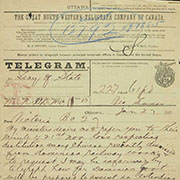CANADA HISTORY - DOCUMENTS INTERNATIONAL
Convention (III) For the Adaptation to Maritime Warfare of the Principles of the Geneva Convention of 22 August 1864
Analysis of the Document - (The Document follows below the Analysis)
The Convention (III) for the Adaptation to Maritime Warfare of the Principles of the Geneva Convention of 22 August 1864, adopted in 1907 at The Hague, extended the humanitarian principles of the original Geneva Convention to maritime warfare. For Canada, this marked an important step in the evolution of its naval responsibilities and its growing international profile, particularly as the country began to assert itself within the framework of British imperial defense during the early 20th century.
The original Geneva Convention of 1864 established protections for the sick and wounded in land warfare, ensuring the humane treatment of combatants and non-combatants alike. The 1907 adaptation sought to apply these same protections to naval warfare, setting standards for the treatment of wounded sailors, shipwrecked personnel, and medical staff at sea. It codified the protection of hospital ships, stipulating that such vessels should not be attacked and that their personnel should be treated with respect and neutrality. This reflected the broader movement of international humanitarian law, expanding its scope to encompass new dimensions of conflict in an increasingly mechanized and global world.
For Canada, the timing of this convention was significant. In 1910, just a few years after the convention's adoption, the country created its own navy with the Naval Service Act, marking its first steps toward naval autonomy. Canada’s decision to establish a navy meant that the principles enshrined in the 1907 convention would soon become directly relevant to its own forces. Although the Canadian Navy was initially small, it quickly became clear that Canada’s naval forces would be part of the broader Imperial defense system, particularly during World War I. This meant that Canada had a direct stake in adhering to international norms for maritime warfare, ensuring that its sailors and naval personnel were protected under the conventions of war.
The influence of the convention on Canadian military conduct during World War I was profound. As Canada’s navy grew in size and capability, it found itself increasingly involved in operations against German U-boats in the North Atlantic. The Convention for the Adaptation of the Principles of the Geneva Convention played a role in ensuring that Canadian sailors, particularly those who were wounded or captured, were afforded humane treatment in line with international law. This extended to shipwrecked personnel and medical staff who were entitled to the protections established by the convention.
Beyond its direct military implications, the convention also reflected Canada's broader commitment to international law and humanitarian principles. The treaty’s provisions aligned with Canada’s evolving identity as a nation that valued peace, diplomacy, and the rule of law. This commitment would continue throughout the 20th century, as Canada became increasingly involved in international organizations like the League of Nations and later the United Nations, advocating for peace and the humane treatment of combatants and civilians alike.
The convention’s legacy in Canada can also be traced to the country's growing role in international humanitarian efforts, particularly through its participation in the development of modern international law. Canada's leadership in international diplomacy, including its contributions to later treaties such as the Geneva Conventions of 1949 and the Additional Protocols of 1977, reflected a long-standing commitment to the principles first articulated in 1864 and adapted for maritime warfare in 1907. Canada's involvement in peacekeeping missions and its emphasis on human rights have their roots in this earlier period of international humanitarian development.
In conclusion, the Convention (III) for the Adaptation to Maritime Warfare of the Principles of the Geneva Convention had significant implications for Canada’s emerging naval forces and its position within the international legal framework. It provided crucial protections for sailors, medical personnel, and shipwrecked individuals during warfare, principles that would guide Canada’s conduct in both world wars and beyond. The convention also reflected Canada's broader engagement with humanitarian law and international diplomacy, a legacy that continues to shape the country’s role on the global stage.

Signed at The Hague, 29 July 1899.
ENTRY INTO FORCE: 4 September 1900. No longer in force.
Alike animated by the desire to diminish, as far as depends on them the evils inseparable from warfare, and wishing with this object to adapt to maritime warfare the principles of the Geneva Convention of 22 August 1864, have decided to conclude a convention to this effect:
They have, in consequence, appointed as their Plenipotentiaries, to wit:
(Here follow the names of Plenipotentiaries)
Who, after communication of their full powers, found in good and due form, have agreed on the following provisions:
Article 1. Military hospital ships, that is to say, ships constructed or assigned by States specially and solely for the purpose of assisting the wounded, sick or shipwrecked, and the names of which shall have been communicated to the belligerent Powers at the beginning or during the course of hostilities, and in any case before they are employed, shall be respected and cannot be captured while hostilities last.
These ships, moreover, are not on the same footing as men-of-war as regards their stay in a neutral port.
Art. 2. Hospital ships, equipped wholly or in part at the cost of private individuals or officially recognized relief societies, shall likewise be respected and exempt from capture, provided the belligerent Power to whom they belong has given them an official commission and has notified their names to the hostile Power at the commencement of or during hostilities, and in any case before they are employed.
These ships should be furnished with a certificate from the competent authorities, declaring that they have been under their control while fitting out and on final departure.
Art. 3. Hospital ships, equipped wholly or in part at the cost of private individuals or officially recognized societies of neutral countries, shall be respected and exempt from capture, if the neutral Power to whom they belong has given them an official commission and notified their names to the belligerent Powers at the commencement of or during hostilities, and in any case before they are employed.
Art. 4. The ships mentioned in Articles 1, 2 and 3 shall afford relief and assistance to the wounded, sick, and shipwrecked of the belligerents independently of their nationality.
The Governments engage not to use these ships for any military purpose.
These ships must not in any way hamper the movements of the combatants.
During and after an engagement they will act at their own risk and peril.
The belligerents will have the right to control and visit them; they can refuse to help them, order them off, make them take a certain course, and put a commissioner on board; they can even detain them, if important circumstances require it.
As far as possible the belligerents shall inscribe in the sailing papers of the hospital ships the orders they give them.
Art. 5. The military hospital ships shall be distinguished by being painted white outside with a horizontal band of green about a metre and a half in breadth.
The ships mentioned in Articles 2 and 3 shall be distinguished by being painted white outside with a horizontal band of red about a metre and a half in breadth.
The boats of the ships above mentioned, as also small craft which may be used for hospital work, shall be distinguished by similar painting.
All hospital ships shall make themselves known by hoisting, together with their national flag, the white flag with a red cross provided by the Geneva Convention.
Art. 6. Neutral merchantmen, yachts, or vessels, having, or taking on board, sick, wounded, or shipwrecked of the belligerents, cannot be captured for so doing, but they are liable to capture for any violation of neutrality they may have committed.
Art. 7. The religious, medical, or hospital staff of any captured ship is inviolable, and its members cannot be made prisoners of war. On leaving the ship they take with them the objects and surgical instruments which are their own private property.
This staff shall continue to discharge its duties while necessary, and can afterwards leave when the commander-in-chief considers it possible.
The belligerents must guarantee to the staff that has fallen into their hands the enjoyment of their salaries intact.
Art. 8. Sailors and soldiers who are taken on board when sick or wounded, to whatever nation they belong, shall be protected and looked after by the captors.
Art. 9. The shipwrecked, wounded, or sick of one of the belligerents who fall into the hands of the other, are prisoners of war. The captor must decide, according to circumstances, if it is best to keep them or send them to a port of his own country, to a neutral port, or even to a hostile port. In the last case, prisoners thus repatriated cannot serve as long as the war lasts.
Art. 10. The shipwrecked, wounded, or sick, who are landed at a neutral port with the consent of the local authorities, must, failing a contrary arrangement between the neutral State and the belligerents, be guarded by the neutral State, so that they can not again take part in the military operations. The expenses of tending them in hospital and internment shall be borne by the State to which the shipwrecked, wounded, or sick belong.
Art. 11. The rules contained in the above articles are binding only on the Contracting Powers, in case of war between two or more of them. The said rules shall cease to be binding from the time when, in a war between the Contracting Powers, one of the belligerents is joined by a non-Contracting Power.
Art. 12. The present Convention shall be ratified as soon as possible. The ratifications shall be deposited at The Hague. On the receipt of each ratification a procäs-verbal shall be drawn up, a copy of which, duly certified, shall be sent through the diplomatic channel to all the Contracting Powers.
Art. 13. The non-Signatory Powers who accepted the Geneva Convention of 22 August 1864, are allowed to adhere to the present Convention. For this purpose they must make their adhesion known to the Contracting Powers by means of a written notification addressed to the Netherlands Government, and by it communicated to all the other Contracting Powers.
Art. 14. In the event of one of the High Contracting Parties denouncing the present Convention, such denunciation shall not take effect until a year after the notification made in writing to the Netherlands Government, and forthwith communicated by it to all the other Contracting Powers. This denunciation shall only affect the notifying Power. In testimony whereof the respective Plenipotentiaries have signed the present Convention and affixed their seals thereto.
Done at The Hague, 29 July 1899, in a single copy, which shall be kept in the archives of the Government of the Netherlands, and copies of which duly certified, shall be sent through the diplomatic channel to the Contracting Powers.
Cite Article : www.canadahistory.com/sections/documents
Source:



